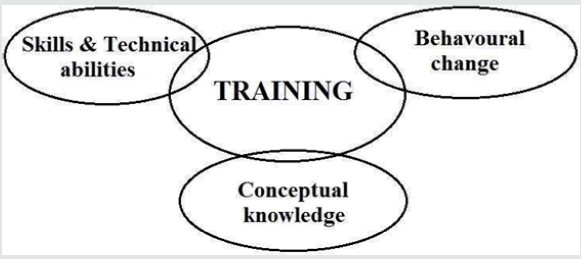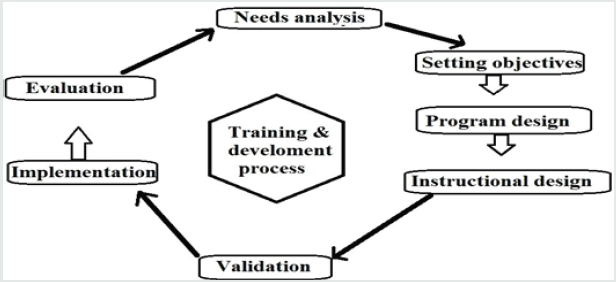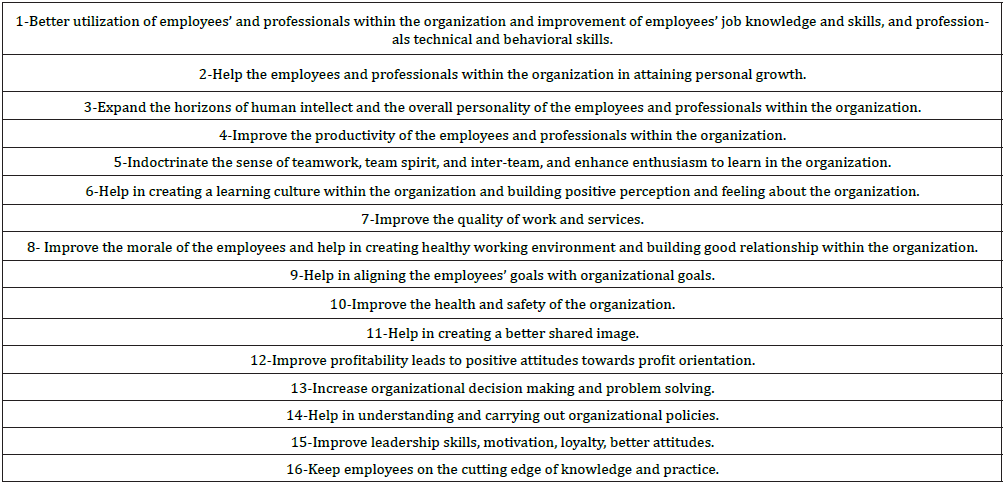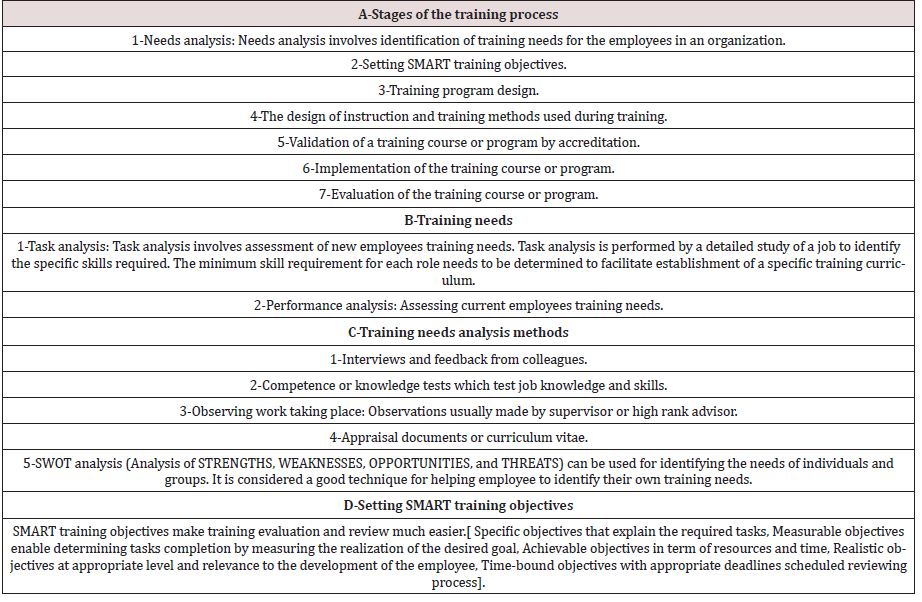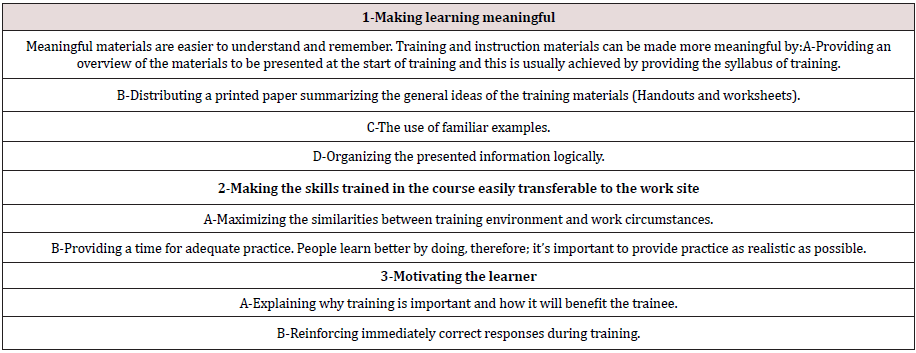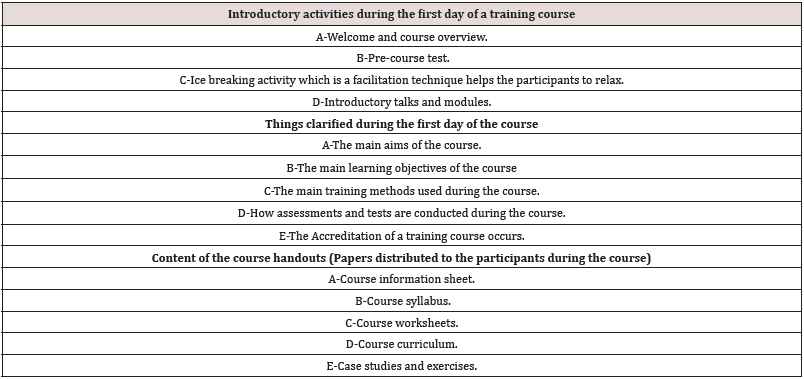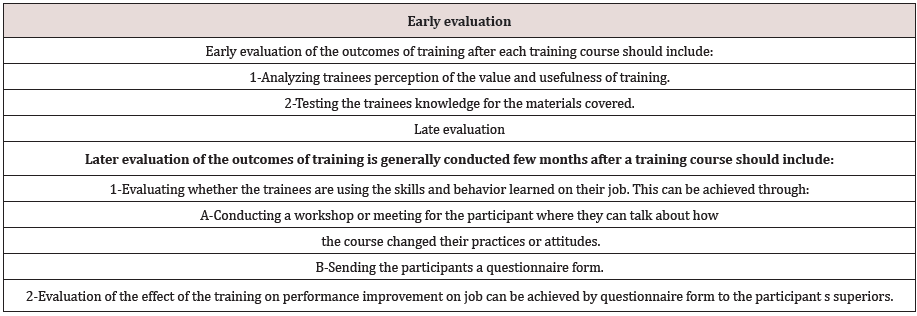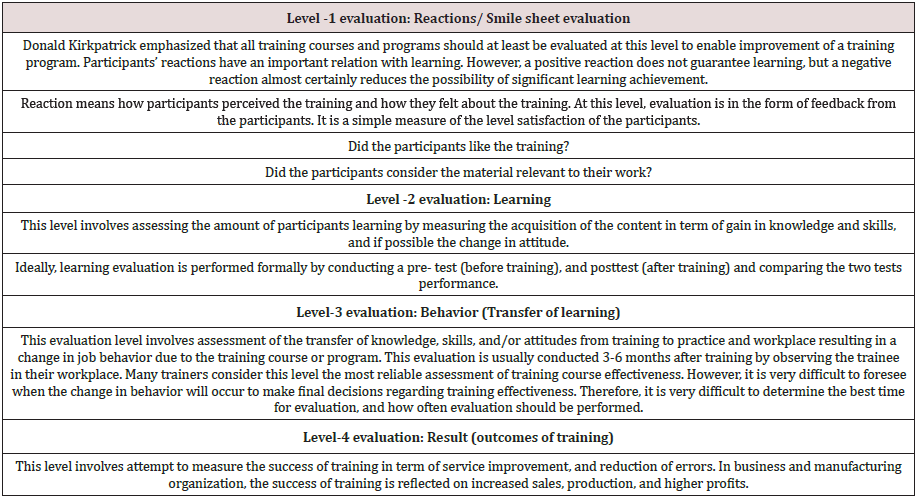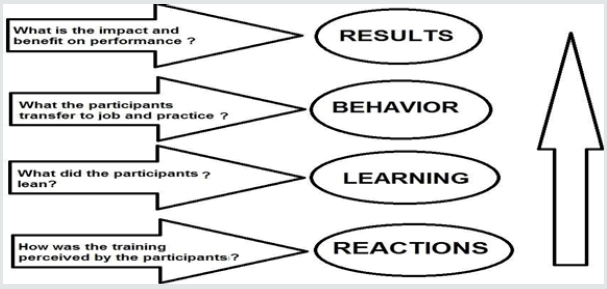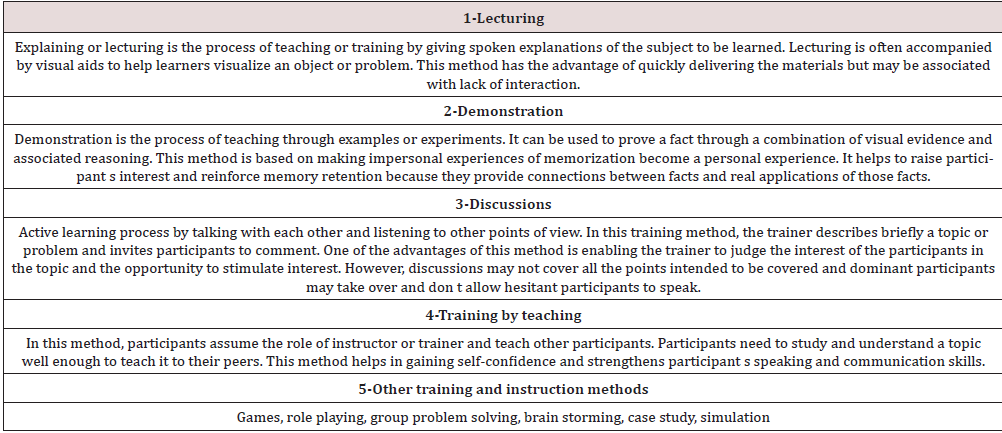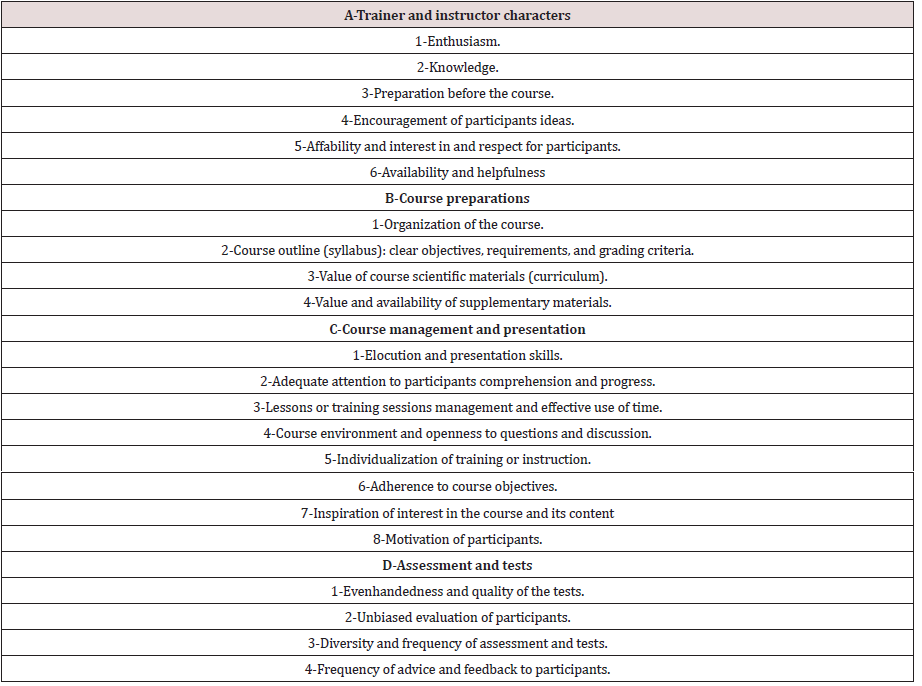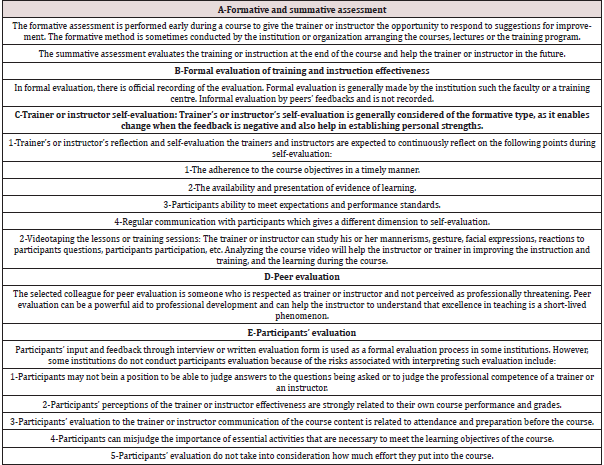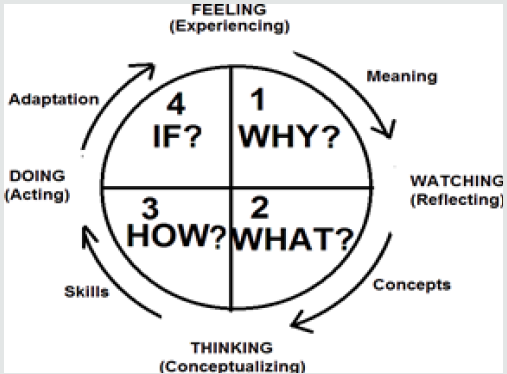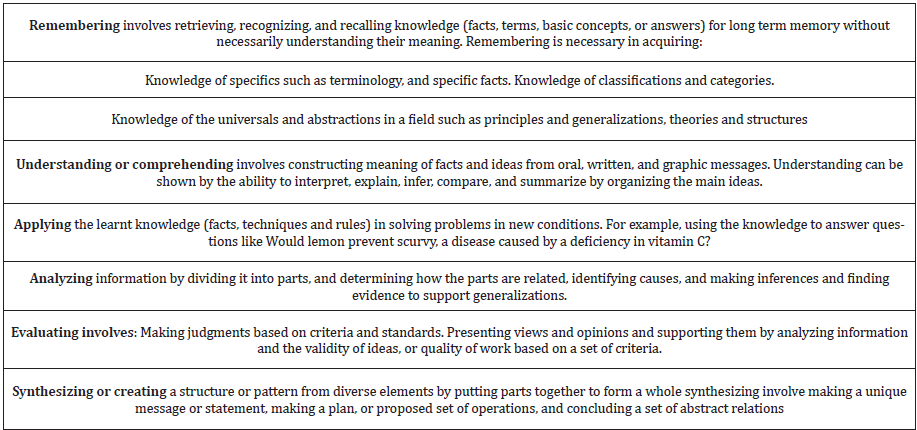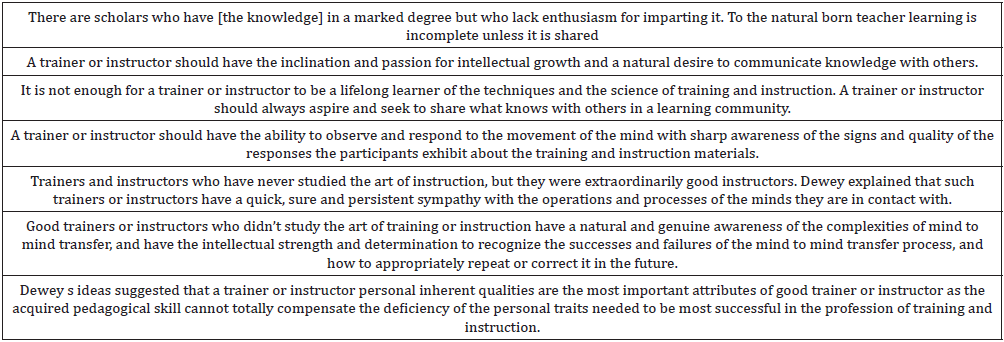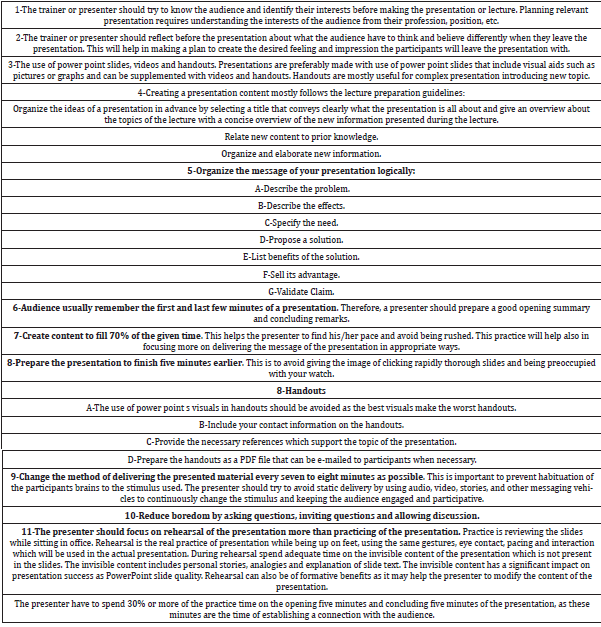
Lupine Publishers Group
Lupine Publishers
Menu
ISSN: 2637-6679
Research Article(ISSN: 2637-6679) 
Essential Training Knowledge for Physicians Working in the Field of Professional Training and Development, and Medical Schools’ Instruction Volume 4 - Issue 3
Aamir Jalal Al-Mosawi*
- Head, Iraq Headquarter of Copernicus Scientists International Panel, Baghdad, Iraq
Received: October 30, 2019; Published: November 25, 2019
Corresponding author: Aamir Jalal Al-Mosawi, Head, Iraq Headquarter of Copernicus Scientists International Panel, Baghdad, Iraq
DOI: 10.32474/RRHOAJ.2019.04.000187
Abstract
- Abstract
- Introduction
- Materials and Methods
- Results
- Discussion
- Domains of Change During Training
- Instruction Methods
- Teaching or Instruction Vs. Learning During a Training Course
- VAK Learning Model
- The Application of Learning Theories in Training and Instruction
- Instructional Scaffolding
- Conclusion
- References
Background: The increasing complexity of medical care environment, and medical education and practices made understanding the principles and concepts of training, development, and the related concepts and disciplines necessary for doctors practicing at almost any level in a healthcare system. The aim of this paper is to identify the essential training knowledge needed by physicians working in the field of professional training and development (Professional trainers) and medical schools’ instruction. These essential knowledges should include in the content of any training of the trainer (TOT) courses conducted for physicians.
Materials and methods: More than 100 relevant publications were identified and reviewed.
Results: The essential training knowledge needed by physicians working in the field of professional training and development (Professional trainers) included adequate knowledge about accreditation of a training course, the need for professional training, training and development in a healthcare organization, domains of change during training, the influences of professional training and development, the training process (Stages of the training process, training needs, training needs analysis methods, training needs analysis methods, Setting SMART training objectives), designing an effective training course, Popular training methods, What a professional trainer needs to understand and do before and during a training course development, ,how to conduct a professional training course , the main principles of training course evaluation, the evaluation of a training course using Kirkpatrick’s four levels of evaluation, the commonly used methods of instruction and training, training and instruction effectiveness, training and instruction effectiveness evaluation, participants learning assessment during training and instruction, learning process for trainers and instructors, VAK learning model, VARK learning model of Neil D. Fleming, the 4MAT learning model of Bernice McCarthy, the application of learning theories in training and instruction, the cognitive (knowledge-based) domain of learning and training , Bloom’s taxonomy and its practical value in training and medical schools’ instruction, behaviorist model of learning (The operant conditioning), the ideas of John Dewey relevant to training and instruction, constructivist learning theory, Jean Piaget’s cognitive theory, the practical applications of Jean Piaget ideas in training and instruction, Lev Vygotsky ideas’ practical application in training and instruction including the zone of proximal development, the concept of Instructional scaffolding suggested by Jerome Seymour Brunerm, the fundamental principles of learning relevant to training and medical schools’ instruction, the fundamental principles of learning relevant to training and medical schools’ instruction, the principles of Adult learning (Andragogy) suggested by Malcolm Shepherd Knowles, the principles of the constructivist’s approaches for adult training and instruction, the main principles of adult training and instruction that distinguish adult learners from children and youth, the principles of making presentation, what a TOT course is all about and he need for TOT courses.
Conclusion: This research article provided a compendium of the essential training knowledge needed by physicians working in the field of professional training and development (Professional trainers).
Keywords: Professional training; physician development; medical schools’ instruction; TOT courses
Introduction
- Abstract
- Introduction
- Materials and Methods
- Results
- Discussion
- Domains of Change During Training
- Instruction Methods
- Teaching or Instruction Vs. Learning During a Training Course
- VAK Learning Model
- The Application of Learning Theories in Training and Instruction
- Instructional Scaffolding
- Conclusion
- References
The increasing complexity of medical care environment, and medical education and practices made understanding the principles and concepts of training, development, and the related concepts and disciplines necessary for doctors practicing at almost any level in a healthcare system. The aim of this paper is to identify the essential training knowledge needed by physicians working in the field of professional training and development (Professional trainers) and medical schools’ instruction. These essential knowledges should include in the content of any training of the trainer (TOT) courses conducted for physicians.
Materials and Methods
- Abstract
- Introduction
- Materials and Methods
- Results
- Discussion
- Domains of Change During Training
- Instruction Methods
- Teaching or Instruction Vs. Learning During a Training Course
- VAK Learning Model
- The Application of Learning Theories in Training and Instruction
- Instructional Scaffolding
- Conclusion
- References
More than 100 relevant publications were identified and reviewed.
Results
- Abstract
- Introduction
- Materials and Methods
- Results
- Discussion
- Domains of Change During Training
- Instruction Methods
- Teaching or Instruction Vs. Learning During a Training Course
- VAK Learning Model
- The Application of Learning Theories in Training and Instruction
- Instructional Scaffolding
- Conclusion
- References
The essential training knowledge needed by physicians working in the field of professional training and development (Professional trainers) included adequate knowledge about accreditation of a training course, the need for professional training, training and development in a healthcare organization, domains of change during training, the influences of professional training and development, the training process (Stages of the training process, training needs, training needs analysis methods, training needs analysis methods, Setting SMART training objectives), designing an effective training course, Popular training methods, What a professional trainer needs to understand and do before and during a training course development, ,how to conduct a professional training course , the main principles of training course evaluation, the evaluation of a training course using Kirkpatrick’s four levels of evaluation, the commonly used methods of instruction and training, training and instruction effectiveness ,training and instruction effectiveness evaluation, participants learning assessment during training and instruction, learning process for trainers and instructors, VAK learning model, VARK learning model of Neil D. Fleming, the 4MAT learning model of Bernice McCarthy, the application of learning theories in training and instruction, the cognitive (knowledgebased) domain of learning and training , Bloom’s taxonomy and its practical value in training and medical schools’ instruction, behaviorist model of learning (The operant conditioning), the ideas of John Dewey relevant to training and instruction, constructivist learning theory, Jean Piaget’s cognitive theory, the practical applications of Jean Piaget ideas in training and instruction, Lev Vygotsky ideas’ practical application in training and instruction including the zone of proximal development, the concept of Instructional scaffolding suggested by Jerome Seymour Brunerm, the fundamental principles of learning relevant to training and medical schools’ instruction, the fundamental principles of learning relevant to training and medical schools’ instruction, the principles of Adult learning (Andragogy) suggested by Malcolm Shepherd Knowles, the principles of the constructivist’s approaches for adult training and instruction, the main principles of adult training and instruction that distinguish adult learners from children and youth, the principles of making presentation, what a TOT course is all about and he need for TOT courses.
Discussion
- Abstract
- Introduction
- Materials and Methods
- Results
- Discussion
- Domains of Change During Training
- Instruction Methods
- Teaching or Instruction Vs. Learning During a Training Course
- VAK Learning Model
- The Application of Learning Theories in Training and Instruction
- Instructional Scaffolding
- Conclusion
- References
Accreditation of a training course
Accreditation of a training course occurs when an independent scientific body evaluates a training course, the training methodology used in the course, and the qualifications of the trainers and lecturers of the course and approve the course. Unaccredited courses are now generally recognized as a waste of time of resources [1,2].
The need for professional training
Training and development as a discipline falls into two main
categories or levels:
a. Personal training and development.
b. Training and development in an organization which is
generally called human resource training and development.
The importance of professional training and development has become well recognized and accepted by many organizations and institutions. Training and development are considered by some organizations as an investment and not an expense because of its rewarding influences. Figure 1 shows why Training and development is considered by some organizations as an investment and not an expense. Training and development are commonly used as an organization investment in its own cadre enables the organizations to surpass their competitors. For example, a study published in the British Journal of Surgery concluded that after the initial training period, laparoscopic cholecystectomy is less expensive than the open operation and represents a costeffective method for treatment of patients with gallstones [3]. However, when training and development programs don’t follow the accepted scientific principles and cannot be accredited, it becomes unnecessary burden and a source of distraction [3,4]. Better performance is associated with training and is generally attributed to the fact that properly trained professionals are more capable of meeting the job expectations than the untrained professionals [3,4]. In addition, training helps the organization in reducing redundant works which reduces performance. Training and development are also considered by some organizations as a retention tool for the employees and professionals as they will perceive training and development as a commitment from the organization [3,4]. Professional training and development help in the creation of learning and creative environment and fostering creative thinking which help the organization or institution to find solutions to problems. However, despite all the benefits associated with training, there is no point in training just for the sake of training or training everyone in the organization or institution without considering what the organization or institution is trying to achieve and how training and development programs help in achieving organizational goals [5]. For example, if a hospital found a high rate of infection, it may be considered that infection control training is required for a certain number of selected staff whom training is expected to help in controlling the rate of infection in the hospital and reduces the extra-expenses. In healthcare organizations, training is considered to be an important factor in the reduction of medical errors. Understanding the principles and concepts of training, development, and the related concepts and disciplines has become necessary for doctors practicing at almost any level because of:
a. The increasing complexity of medical care environment,
and medical education and practices.
b. Physicians particularly consultants are frequently placed
in teaching and training positions.
c. Many doctors are responsible for the training and
development of employees who are not doctors such as nurses,
allied health professionals, and other management employees
[3,4].
Professional training is an activity that is focused on and evaluated against the job that an individual hold. When doctors are graduated from medical schools, they have the knowledge, but they lack the skills. Training during rotation residency is a classic example of professional medical training that aims at providing the participants the basic skills they need to perform their job or developing new skills [3,4], [6-8].
Development training is an activity that focuses on the activities that individuals in an organization or institution may participate or contribute to in the future. Developing a doctor to be a trainer in a certain field may demand enrollment in a development course called training of the trainers course (TOT).Developing a doctor to be instructor in a university may demand enrollment in a development course called instruction methods. Developing a doctor to be a hospital manager or director demands enrolling him in a hospital management training course or courses. Developing healthcare professionals to be more understanding of the healthcare environment and more capable of adapting to the continuously changing healthcare environment and to enable them to be more creative may demand enrolling them in a medical leadership and healthcare leadership training course or courses [3,4],[6-9].Development training must support the organization’s strategic goals. For example, if one medical organization’s goal is to enable employees and professionals to have higher certificate in an other countries, training in multiple languages can help the achievement of this goal. If a hospital has a goal of attracting patients (clients) from other geographic regions, again training the employees in multiple languages can also help the achievement of this goal [3,4], [6-8]. The need for the acquisition of new knowledge and skills to enable organizations the provision of modern sophisticated services, and ultimately making the services equivalent to the services provided by similar contemporary organization throughout the world, led to the emergence of the concept of continuing professional development, and consequently the development of continuing professional development programs which are also called continuing professional education programs. The need for the acquisition of new knowledge and skills to enable organizations the provision of modern sophisticated services is one of the important cornerstones of any continuing professional development program. The other cornerstone of any professional training development program is the access to an independent scientific professional body or committee to establish accredited training activities or to evaluate and accredit the already exiting training activities. The presence of suitable incentive that encourages professionals to join the training and development activity which provides the knowledge and skills needed by the organization is another important cornerstone of any professional development program. Training and development centers have been established in many universities and national departments (ministries) with the main aims and functions of establishing or supporting the development of accredited training and development activities, and also developing a well-qualified trainers capable of working efficiently within the training and development system who are capable of designing and conducting training and development activities [3-11]. The required scientific and professional activities for professionals cannot be determined by training and development centers. In the case of healthcare professionals for example, the required scientific and professional activities should be determined by colleges of medicine, nursing, and dentistry; professional associations of medicine, nursing, and dentistry; and specialization boards [3-8].
Training and development in a healthcare organization Professional training of residents in rotation is generally the responsibility of hospital administration and hospital departments and sections. Professional training of general practitioners is generally the responsibility of the medical association, and in some countries like Iraq should be arranged by health sectors and directorate affiliated to the department (ministry) of health. Professional training of specialty residents is generally the responsibility of the boards of medical specializations and hospital departments and sections. Development training is generally the responsibility of training and development centers [3,4].
Domains of Change During Training
- Abstract
- Introduction
- Materials and Methods
- Results
- Discussion
- Domains of Change During Training
- Instruction Methods
- Teaching or Instruction Vs. Learning During a Training Course
- VAK Learning Model
- The Application of Learning Theories in Training and Instruction
- Instructional Scaffolding
- Conclusion
- References
Change generally occurs in three domains during training (Figure 1):
Table 6:What a professional trainer needs to understand and do before and during a training course development [3,4].

a. Conceptual knowledge: training is associated with gain in conceptual knowledge.
b. Skills and technical abilities: training is associated with acquisition of skills and enhancement of technical abilities.
c. Behavioral change: training foster positive attitudes and behaviors which is mostly by the transfer of learning to the workplace
Table 1 summarizes the influences of professional training and development. Table 2 summarizes the components of the training process. Figure 2 shows the cycle of the training and development process. Table 3 summarizes how to design an effective training course. Table 4 summarizes the popular training methods. Each of these methods has advantages and disadvantages. However, depending on the situation each method can be a valuable tool for teaching employees’ new skills and behaviors. Lecturing is one of the most popular instruction and training methods. During traditional lecture, the trainer or instructor usually talks, and the participants listen with or without taking notes. During lecturing, training and learning materials can be covered easily and quickly. However, lecturing can be associated with lack of interaction and high likelihood of boredom. It is pity to observe many who lacks the experience of lecturing make a lecture by copying texts from books or other sources converting this training and instruction method of lecturing into something more like a book reading. Experts have suggested that instead of reading a text brought from books, articles and other sources, it will be more convenient and time saving to ask the audience to read the chosen text or article. Therefore, in order to avoid the unnecessary practice of book or article reading instead of lecturing, a lecture should include at least 10 references. For lectures in the field of applied sciences like medicine, at least seven of the references should be scientific journal articles and the use of books as a reference is preferably limited to three or less [3,4]. Table 5 summarizes how to prepare a lecture. Table 6 summarizes what a professional trainer needs to understand and do before and during a training course development
How to conduct a professional training course
A training course begins by welcoming the participants and ice breaking activities followed by general introductory talks and some introductory modules. A training course is usually divided into training sessions; each of them includes several modules. It is important during the first day of a training course to clarify the main aims and learning objectives of the course and the main training methods used during the course, and also how assessments and tests are conducted during the course. The introductory modules in the first day of this course were about accreditation of a training course and the need for professional training. A training day should conclude by summarizing what happened during the day (Figure 3). In general, a professional trainer should always finish each training day by a conclusion remarks summarizing what happened during the day [12-15]. It also important that a professional trainer collect the participants feedback and remarks after each training day, and this can be achieved the participants the following questions:
a. What is the topic that you liked most?
b. Is there a thing come to your mind and you want to learn
more about it?
c. What is the topic that you didn’t like?
Training evaluation is a continuous and systematic process of
assessing the value or potential value of a training course, activity
or event. When designing a training program, it is mandatory to
consider the consequent need for evaluation. A training course
or program should be designed against specific objectives and
expected benefits. This design will enable evaluation of the
successfulness of a training course against certain achievement
indicators. Therefore, evaluation models are designed to make
the progress of the training program clearly reflected through
the periodical evaluations [3,4,16-18]. Table 7, 8 summarizes the
main principles of training course evaluation. Figure 4 shows
Kirkpatrick’s four levels model. Table 9 summarized the evaluation
of a training course using Kirkpatrick’s four levels of evaluation.
Instruction Methods
- Abstract
- Introduction
- Materials and Methods
- Results
- Discussion
- Domains of Change During Training
- Instruction Methods
- Teaching or Instruction Vs. Learning During a Training Course
- VAK Learning Model
- The Application of Learning Theories in Training and Instruction
- Instructional Scaffolding
- Conclusion
- References
An instruction method refers to the principles and methods used for teaching. Table 10 summarizes the methods of instruction and training.
Training and instruction effectiveness
Many factors affect the effectiveness of training and instruction including the trainer or instructor character, and participants characteristics such as individual interests, ability to meet course tasks. In addition to the characteristics of the course itself. The trainer or instructor cannot control all the factors especially when working as a part of a team. In some circumstances, the course materials, course outline and textbook are determined by a committee rather by the trainer on instructor. Instructors may teach in courses that are a part of a degree program in which certain objectives, determined by the institution granting the degree. The trainer or instructor is expected to try to maximize input into the controllable factors that influence training and instructional outcomes and, the assessment of training or instruction [3,4]. Table 11 summarizes the factors affecting training and instruction effectiveness. Table 12 summarizes the principles of training and instruction effectiveness evaluation.
Participants learning assessment during training and instruction
Assessment is a diagnostic aid that helps in establishing effective instruction and training through measuring participants learning achievement. Participants learning needs cannot be met without regular assessment. In addition, participants learning assessments provide the participants themselves, the necessary awareness about what they understand and also about the gaps in their knowledge [3,4]. Diagnostic assessment facilitates designing training and instruction and help in determining the participants levels. Diagnostic learning assessments can be performed formally or informally. It usually performed at the beginning of training or instruction to determine the pre-training or pre-instruction learning, ability level and the learning needs of the participants [3,4]. Diagnostic assessment enables enhancement of instruction and training effectiveness through [3,4], Helping the trainer or instructor in developing an insight of the diversity of the participants learning ability and of the training and instructional needs of the participants. Facilitates making the necessary changes to training sessions or lessons to meet the needs of the learners. Formal diagnostic assessment usually includes tests, quizzes, or pre-tests. Informal assessment can be performed through:
a. Homework assignments.
b. Training sessions practice and activities.
c. Effective questioning techniques to determine depth of
understanding of a concept.
d. Assignments designed to target certain skills.
Traditional summative assessment or the traditional assessment of learning usually performed as a test or exam at the end of a training course. Summative assessments are also useful in evaluating curriculum, or participant placement in more advanced courses.
Formative assessment is a part of training or instruction process which assesses participants learning and is performed early during a training course. Formative assessment is performed to develop an earlier understanding of the participants learning. It can be performed formally by conducting a quiz or informally through observation participants understanding during training sessions. Formative assessment discloses the gaps in participants understanding, thus enabling the trainer or instructor to make the necessary adjustment. It also facilitates participants awareness of the progress made and enable them focus on the next step [3,4].
Formative assessment methods include [3,4]:
a. Formal assessment of tasks by monitoring of homework
tasks, quizzes, presentations, performances, experiments,
debates, etc.
b. Observation of learners practice, acquisition of new skill,
and their work with a new concept.
c. Regular checks for participants understanding.
d. Trainer-participants meeting is considered very effective
way of monitoring participants progress with additional
advantage of enhancing the trainer-participants relationship.
e. End of session form measures the learned knowledge and
uncovers possible knowledge gaps. Questions in the form my
include:
f. What is the one most important thing you learned from
this session?
g. What is the thing that gave you some difficulty?
h. What thing you would like to know more about it?
Learning process for trainers and instructors Learning can be defined as relatively permanent changes in behaviour, skills, knowledge or attitudes resulting from particular experiences. Learning can be cognitive, physical, social, or emotional.
Permanence is a cardinal feature of learning and temporary changes are not considered learning. Forgotten materials represent a lost change can’t be regarded as being learnt.
Teaching or Instruction Vs. Learning During a Training Course
- Abstract
- Introduction
- Materials and Methods
- Results
- Discussion
- Domains of Change During Training
- Instruction Methods
- Teaching or Instruction Vs. Learning During a Training Course
- VAK Learning Model
- The Application of Learning Theories in Training and Instruction
- Instructional Scaffolding
- Conclusion
- References
Teaching or instruction is the teacher s (instructor s or trainer s) efforts. Learning is what participants achieve from their efforts. Therefore, learning is not referring only to the experiences and what are encountered in training courses or lectures as important part of participants efforts may be achieved outside the training courses, lectures, etc. The training environment, and the number of participants in the course, can affect learning, and how training should be conducted. The learning materials are generally presented as curriculum content and the skills expected to be learned during the course. During the process of teaching in a lecture or a training course, an additional unintended learning may occur alongside the explicit learning of the official curriculum and is called incidental learning. This type of learning occurs without the trainer or learner deliberately trying to make it happen. The initial preparedness of the course participants or the lecture attendee to cope with or get benefit from the activities has an important influence on learning. The concept of readiness and preparedness is applicable not only to course participants and trainees, but also to the trainers and instructors who need to be ready and prepared to plan a training course. To ensure the permanence of change during a training course, it is important to transfer the taught materials to future practice. After the training course the participants should be able to use knowledge or skill in their real practice [19-24].
VAK Learning Model
- Abstract
- Introduction
- Materials and Methods
- Results
- Discussion
- Domains of Change During Training
- Instruction Methods
- Teaching or Instruction Vs. Learning During a Training Course
- VAK Learning Model
- The Application of Learning Theories in Training and Instruction
- Instructional Scaffolding
- Conclusion
- References
People vary in their learning orientation. Learners’ preferences originally divided into three common categories, referred to as the VAK model. According to this model, trainers and instructors have to use various approaches to engage all participants with various learning styles which include visual learning auditory learning kinesthetic learning
Visual learners:
prefer pictures, diagrams, and other visuals. They need to see something to know it and may have difficulty learning from lectures.
Auditory learners prefer to get information by listening. They need to hear something to know it and may have difficulty doing activities that include reading. Talking to the participants (lecturing) is more effective with such participants.
Kinesthetic learners prefer hands-on learning. They need to do something to know it. Many kinesthetic learners have the ability to assemble things without reading directions. Exercises and case studies are more effective with such participants [3,4,24].
VARK learning model of Neil D. Fleming
VARK stands for Visual, Aural, Read/write, and Kinesthetic
sensory modalities that are used for learning information. Before
Fleming’s work, the VAK was used. Fleming added a fourth model
by dividing the Visual dimension (the V in VAK) into two parts;
Visual (V) and text as Read/write (R). Fleming designed the VARK
model while working as an inspector for the New Zealand education system. Fleming thought that some eminent teachers could not
reach some students while other less reputed teachers could.
Therefore, he designed the VARK model based on his experiences,
and work with students and teachers at Lincoln University.
Visual preference includes the representation of information in
maps, diagrams, charts, graphs, flow charts, labelled diagrams, and
all the symbolic arrows, circles, hierarchies and other methods that
trainers and instructors could use to represent instead of words.
Therefore, this preference style could can also be called Graphic (G)
preference. The visual preference does not generally include real
pictures or photographs, videos or PowerPoint. It includes designs,
shapes and the different formats that are used to highlight and
convey information. Drawing a diagram with meaningful symbols
on a whiteboard is helpful for people with a visual preference.
Auditory learners
Have preference for information that is heard or spoken. Auditory learners learn best from lectures and group discussion.
Read / write preference
Learners need information to be displayed as words and text-based input and output (reading and writing) in all its forms including PowerPoint, handouts, articles, and assignments.
Kinesthetic
Means the perceptual preference of using experience and practice (simulated or real). Kinesthetic preference includes demonstrations, simulations, videos and movies of real things, case studies, practice and applications. Kinesthetic learners learn better by doing and performing activities, rather than listening to a lecture or watching demonstrations. Kinesthetic learners are generally known as “doers”. Many learners are multimodal in their learning preference and have two, three or four almost-equal learning preferences [3,4,21].
The 4MAT learning model of Bernice McCarthy
Dr. Bernice McCarthy from the United States developed the first basic structure of the 4MAT system in the late 1970s.Thereafter, the method has systematically and continuously been used and developed. The 4MAT model was developed with aim of helping trainers understand participants differences in their learning preferences, and how engage all participants by modifying the events of training or instruction based on understanding brain lateralization dominance and learning style to make training more attractive to each specific learner type. Bernice McCarthy suggested that the learning experience include two main parts: 1-Perceiving during learning occurs in two ways: Experiencing which is feeling and sensing the learning through experience. Conceptualizing which is thinking to translate the experience into the conceptual forms such as ideas and systems. The interaction between feeling the experience and thinking during conceptualization is important in connecting the personal values and perception of the participants to those of the trainer or instructor. 2-Processing what the learner perceived occurs also in two ways:
Watching and making sense of information and what the
learner experienced through internal reflection.
Acting is making sense of new knowledge and information
through external action and applying ideas by doing things and
learning by practicing. Bernice McCarthy, thought that although
most learners engage in many types of learning, they tend to prefer
one of the four major types, and tend to ask a key question:
Imaginative learning involves largely feeling the learning
experience, and seeking personal association, and making
connections. Analytic learning practiced by thinker learner involves
listening to and thinking about information. Analytic learners seek
facts and think through ideas to learn what the expert think to
formulate ideas. Common sense learning involves thinking, doing,
experimenting, create usability, and applying ideas. Dynamic
learning involves largely doing and seeking hidden possibilities
experimenting and exploring. Learners learn by trial and error
and self-discovery, and creating original adaptations [3,4]. Figure
5A shows the types of learning preference styles according to
the 4MAT learning model of Bernice McCarthy. Figure 5B shows
Learner types key questions according to the 4MAT learning model
of Bernice McCarthy. Figure 5C: The learning cycle according to the
4MAT learning model of Bernice McCarthy.
Figure 5A: Types of learning preference styles according to the 4MAT learning model of Bernice McCarthy.
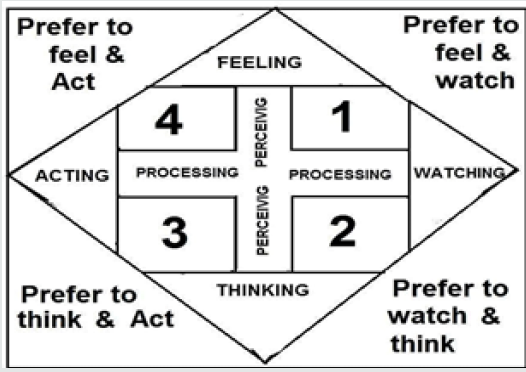
Figure 5B: Types of learning preference styles according to the 4MAT learning model of Bernice McCarthy.

The Application of Learning Theories in Training and Instruction
- Abstract
- Introduction
- Materials and Methods
- Results
- Discussion
- Domains of Change During Training
- Instruction Methods
- Teaching or Instruction Vs. Learning During a Training Course
- VAK Learning Model
- The Application of Learning Theories in Training and Instruction
- Instructional Scaffolding
- Conclusion
- References
Learning is a change in mental association and behavior due to certain experience. There are several theories of learning including theories of behaviorism, constructivism and cognitivism. Understanding learning theories enables the trainer or instructor to develop multiple perspectives into training and instruction. Therefore, learning theories are like multiple windows in a house that enables looking into the same room and get different viewpoints from each window [3,4,22-25].
Cognitive learning
Occurs through the acquisition of knowledge and skills by mental or cognitive processes and information processing. In cognitive learning, the participant learns by listening, watching, touching, reading, or experiencing and then processing and remembering the information. Cognitivism is a learning theory focusing on how information received, organized, stored and retrieved by the mind. Cognitivism views the mind as information processor. According to cognitivism learning theory, training and instruction should focus on achieving three goals: Understanding, Retention and Recalling. Cognitivism emphasizes that better retention and recall of information can be achieved through the use of a well-organized and sequenced training and instruction processes and presenting the information in understandable and meaningful ways. Better understanding can be achieved by activating prior knowledge by beginning the training session or training day by a review quiz and arranging the information into comprehensible parts that include pre- requisite knowledge and using graphics to help structure and relate contents. Retention of information can be improved with use of visual aids and mnemonics like SMART objectives. Cognitivism emphasizes that learning involves recall of stored information, and learning occurs when the learner can recall stored information [3,4].
Behaviourism learning theory
Behaviourism theory of learning is based on making
behavior changes in the learner by repetition and reinforcement.
Behaviourism theory suggests that focusing attention on behavior
instead of on thought during training or instruction with focusing
on what the trainer wants the participants to do.
However, for a beginner (e.g. a medical student), focusing on the
gains in knowledge (Cognitive approach) is necessary and it is more
important to be able to describe how to perform the procedure than actually be able to do it. Therefore, it would be better to
think of both approaches when planning training and instruction
[3,4,22]. Constructivism theory of learning focuses on the inner
thoughts of learners, and how they actively construct knowledge
out of experiences. According to this learning theory, the training
and instruction have to make learners actively involved in a process
of knowledge construction as possible rather than passively
receiving information all the time. Therefore, constructivist
instruction encourages critical thinking, and creates motivated and
independent learners that can build knowledge by doing.
The main ideas of the constructivism learning theory include
Using learner s prior knowledge schema to build upon is associated with more effective learning. In another word, the learners existing knowledge will be the starting point for new learning. Augmenting learning by making the learner actively engaged in the learning process rather than attempting to receive knowledge passively. Learning is best achieved by guiding problem solving [3,4,22-25]. The three major learning theories helped developing more theories that have more practical applications in training and instruction including: Descriptive theories that help in better understanding of learning. Prescriptive or instructional theories that prescribe or describe how to help people learn by suggesting methods to improve learning [3,4,22-25].
The cognitive (knowledge-based) domain of learning and training and Bloom’s taxonomy
The cognitive domain of learning has been the primary focus of the majority of traditional training and instruction. It is frequently used to structure curriculum learning objectives, assessments and activities. The cognitive domain of learning and training was originally suggested by Benjamin Samuel Bloom, who was the chair of the committee of educators who proposed taxonomy of educational objectives based on the classification of educational goals. They published the first volume of the standard text taxonomy of educational objectives. The taxonomy aimed at promoting higher thinking in education such as analyzing and evaluating. In 1956, Bloom edited the first volume of Taxonomy of educational objectives: the classification of educational goal. The publication described a classification of learning objectives (Bloom’s taxonomy) which became an important tool for developing training and educational curriculum. In the original version of Bloom taxonomy, the cognitive domain classified thinking and learning into six levels that are associated with six levels of objectives that can be practically used to create learning objectives for a training course and instruction. In the 2001 revised edition of Bloom’s taxonomy, the levels were a little different and included remembering, understanding or comprehending, applying, analyzing, evaluating, and creating rather than synthesizing the six cognitive levels are generally hierarchical and begin with lower order thinking skills to higher order thinking skills. Learning on higher levels generally demands gaining prerequisite knowledge and skills at lower levels. Bloom’s taxonomy can be used as backbone of training and instructional materials. and trainers can used it as a container for teaching and teaching skills. The taxonomy emphasized higher order thinking of analysis, evaluation, synthesis and creation. Bloom’s taxonomy can also be used as a tool to help balance assessment and evaluative questions in class, assignments and texts to ensure all sorts of thinking are practiced during training [3,4,26,-32]. Table 13 summarizes the six levels of objectives of Bloom’s taxonomy. Table 14 summarizes the practical value of Bloom’s taxonomy in training and instruction.
Behaviorist model of learning (The operant conditioning)
Burrhus Frederic Skinner was probably the first to bring the attention to the similarities between operant conditioning in the original research on tame laboratory rats and operant conditioning in humans. According to Skinner s ideas it is possible to strengthen desired behavior using operant conditioning. Operant conditioning is a learning process associated with likelihood that a specific behavior is increased or decreased through positive or negative reinforcement whenever the behavior is made; in result the individual associates the satisfaction or dissatisfaction with the positive or negative reinforcement. During training operant conditioning begins with the idea that certain consequences tend to make certain behaviors happen more frequently; e.g. if a trainer or an instructor compliments (reinforcement) a participants for a useful comment made (The operant or the learned behavior) during a discussion, there is more chance for more comments to be made in the future. Accordingly, The participants can be motivated and encouraged by giving a strong reason to do the desired action or to accomplish something. Skinner has been respected for suggesting what was considered a much- needed scientific approach to the study of human behavior. However, he has also been criticized for applying findings based largely on animal experiments to human behaviors.
Skinner’s operant conditioning is considered the most common version of behavioral motivation approaches
Reinforcement is the fundamental concept of behaviorism, and it is considered the primary process that forms and controls behavior. Positive reinforcement is the strengthening or reinforcement of behavior by the occurrence of an event or action such as praise after a behavior. Negative reinforcement is the strengthening or reinforcement of behavior by the removal or avoidance of an unwanted event or experience. The behavior of using an umbrella is negatively reinforced by the cessation of rain. Skinner thought that human actions are affected by results of previous actions, events or experiences. Therefore, if a previous a behavior resulted in an undesirable outcome, the behavior will not be repeated. Whereas, if a previous behavior resulted in a desirable outcome, the behavior is likely to occur again in the future. Reinforcement is more effective if it comes immediately after certain operant behavior. For example, the behavior of making a useful comment during a training course is more likely to be reinforced by immediate praise. Operant conditioning affects motivation by encouraging intrinsic (internal) motivation, to the extent that the reinforcement for an activity is the activity itself. For example, when a learner reads a book for enjoyment of reading alone, he is reinforced by the reading itself, and reading is considered to be intrinsically motivated. Operant conditioning is not relevant to all forms of learning. According to Skinner s ideas, effective training and instruction may be based on positive reinforcement which he considered more effective at changing and establishing behavior than punishment. Trainees and learners learn mainly from being punished is how to avoid punishment. For example, if a trainee or a learner is forced to practice something, practicing will be associated with punishment and thus learns to hate and avoid practicing that thing. Trainers and instructors can modify trainee’s behavior, and failure of training and instruction could be attributed to the lack of trainer or instructor an in-depth understanding of training and learning [3,4,33,34]. Skinner’s ideas in training and instruction suggested that Without having adequate knowledge of the science of training and instruction, inappropriate methods and procedures can be used including [3,4,33,34], The use of techniques that may lead to escape and avoidance and undesirable emotional effects. Relying on telling and explaining. Failure to assign learning tasks and to provide positive reinforcement adequately.
The ideas of John Dewey relevant to training and instruction [3,4,35]
a. Learners learn primarily by building on their own
knowledge.
b. Instructors and trainers should design and modify the
curriculum to fit participants prior knowledge and interests.
c. A curriculum needs to focus on the activities and
responsibilities that a course participants or learners will
practice in the future.
Constructivist learning theory
Constructivist theory or constructivism is a learning model suggests that participants can learn through guided experiences and reflecting upon those experiences. The participants are encouraged to actively engage in the process of learning to develop knowledge. The process is more democratic and participants centered. Trainers take the role of facilitator, rather than lecturer. In the constructivism model, trainer’s main role includes promoting critical thinking and create independent learners who develop their own understanding of new knowledge. Models of constructivist learning theory differ about how much a learner constructs knowledge independently, compared to how much they take. However, all models of constructivist learning focus on learner’s thinking rather than learner s behavior, but they have distinctly different implications for training and instruction. There are two main varieties of constructivism; psychological constructivism and social constructivism. Psychological constructivism and social constructivism suggest different approaches for effective instruction and training most effectively. Psychological constructivism emphasizes the independence of learner’s thinking, while social constructivism gives attention to learner s need for social connections while learning. The main idea of psychological constructivism is that learning is achieved by mentally organizing and reorganizing new information or experiences. The organization occurs partly by relating new experiences to prior knowledge that is already meaningful and well understood [3,4].
Jean Piaget’s cognitive theory
Jean Piaget described learning as interplay between two mental activities called assimilation and accommodation. According to Piaget, assimilation and accommodation work together to enrich thinking and to create cognitive equilibrium. Assimilation is the interpretation of new information in terms of pre- existing concepts, information or ideas. Accommodation is the revision or modification of pre-existing concepts in terms of new information or experiences. It occurs alongside assimilation. Piaget ideas suggested the occurrence of two types of adaptations during learning. Assimilation is learner’s response to a new event based on an existing schema, and in accordance with individual needs or conceptions. Accommodation is learner’s modification to an existing schema or learner s formation of a completely new schema to deal with a new experience or event. Cognitive equilibrium is a balance between reliance on prior information and openness to new information. It consists of an ever- growing collection of mental representations for objects and experiences. Piaget called each mental representation a schema. A schema is a concept accompanied by an elaborated mixture of vocabulary, actions and experiences related to that concept. A schema is the mental framework of structured cluster of concepts that is created as a result of the interaction with physical and social environments. Schemata are: Critically important building block of conceptual development. Constantly in the process of being modified or changed. Modified by on-going experiences. A generalized idea usually based on experience or prior knowledge.
The practical applications of Jean Piaget ideas in training and instruction
According to Piaget ideas, instruction and training have to be learner-centered and constructivist to some extent with understanding that participants are adding new concepts to prior knowledge to construct or build understanding. Piaget ideas suggested that trainers and instructors have to consider the learners individual qualities and attitudes during curriculum planning, and add learners thought into the curriculum. Piaget ideas also suggested that trainers and instructors have to nurture and sustain learner’s curiosity and involve learners’ emotions and create a learning environment which makes participants feel safe. According to Piaget s work and ideas, participants can learn by expanding their knowledge and experiences accumulated from infancy to adulthood which are necessary for learning [3,4].
The theories of Dewey and Piaget became part of the movement of progressive education
The thoughts of Dewey and Piaget played crucial role in the development of informal education. Dewey’s ideas suggested that instruction and training must connect with and enlarge experience and thus instructors and trainers have to take the role of exploration of thinking and reflection [3,4,35]. Table 15 summarized John Dewey ideas about trainers and instructors’ qualities. Social constructivism (or socio-cultural theory) emphasizes the importance of the relationships and interactions between a learner and the instructors and trainers who are more knowledgeable or more experienced. The social constructivist theory suggests that learning is like assisted performance. During learning, knowledge or skill from the expert who is skilled and motivated to teach and train can arrange experiences of the learner to allow the learner to practice crucial skills or to construct new knowledge [3,4], Lev Vygotsky suggested that learner’s thinking is influenced by relationships with the more knowledgeable or expert and constructs knowledge better with social interaction with more knowledgeable and expert people. Vygotsky called the difference between what the learner can do alone and what cannot do without assistance, the zone of proximal development (Figure 6).
Figure 6: Vygotsky called the difference between what the learner can do alone and what cannot do without assistance, the zone of proximal development..
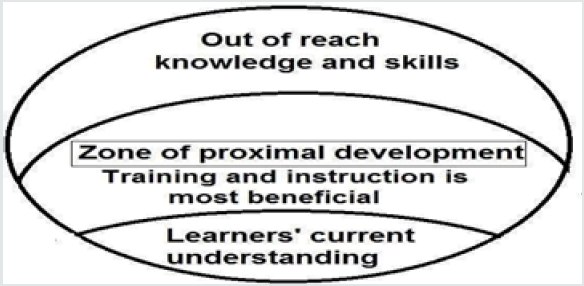
Lev Vygotsky ideas’ practical application in training and instruction included [3,4]
a. Learning should begin by focusing on fields within learners’
zone of proximal development where training or instruction is
most beneficial because it is just beyond participants current
level of capability. With progressive learning the zone of
proximal development will expands allowing the learners to
handle progressively more complex topics.
b. If learning continues within learners’ zone of proximal
development, boring will ensue because the learners
experiencing things that can do or learn independently and
cannot perceive the need for training or instruction.
c. If the trainer or instructor begins training or instruction
with contents that are difficult to achieve even with assistance,
the learners will give up, and there will be a negative impact on
the learner’s self-confidence.
d. The people who help others learn should be more
knowledgeable and expert to be capable of providing the
necessary support and the social interaction which is believed
to affect high order thought processes.
Instructional Scaffolding
- Abstract
- Introduction
- Materials and Methods
- Results
- Discussion
- Domains of Change During Training
- Instruction Methods
- Teaching or Instruction Vs. Learning During a Training Course
- VAK Learning Model
- The Application of Learning Theories in Training and Instruction
- Instructional Scaffolding
- Conclusion
- References
Jerome Seymour Bruner thought that learners could usually learn more than was traditionally expected as long as they were given appropriate guidance and resources. Instructional scaffolding is the phrase that Bruner used to describe the support that learners should be given as they learn. Instructional scaffolding literally means a temporary framework like the ones used to construct buildings, which allows a much stronger structure to be built within it. Bruner emphasized the importance of providing guidance in the proper way and at the appropriate time. When scaffolding is provided correctly, learners appear to be more competent and they learn more. Bruner’s work also suggested that a learner is capable of learning any material provided that the instruction is organized appropriately. Scaffolding is the support needed to help participants in achieving the learning objectives including the interactions aimed at guiding learning. Scaffolding is a strategy than can be used by experienced trainer or instructor to help less experienced participants when the experience difficulty. The process of scaffolding includes dividing learning into steps with the provision of guidance and monitoring. Guidance by providing step by step clear direction explaining what the participants have to do to achieve the objectives of a learning activity. Bruner also suggested the use of the spiral curriculum, an instruction approach in which each subject or skill area is revisited at intervals, at a more sophisticated level each time. First there is a basic knowledge of a subject, and then more sophistication is added, reinforcing principles that were first discussed. Bruner emphasized that learning is stimulated by creating interest in the material rather than by tests or punishment. Learners learn best when the presented knowledge are interesting [3,4]. Table16 summarized the fundamental principles of learning relevant to training and medical schools’ instruction.
Table 16: The fundamental principles of learning relevant to training and medical schools’ instruction.
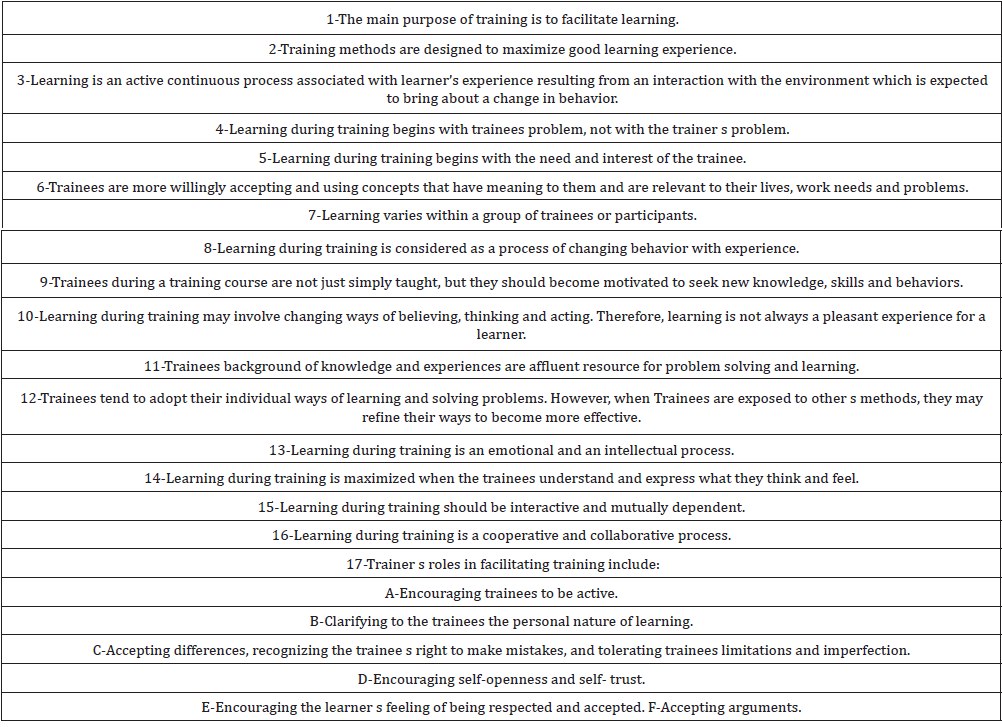
Conclusion
- Abstract
- Introduction
- Materials and Methods
- Results
- Discussion
- Domains of Change During Training
- Instruction Methods
- Teaching or Instruction Vs. Learning During a Training Course
- VAK Learning Model
- The Application of Learning Theories in Training and Instruction
- Instructional Scaffolding
- Conclusion
- References
This research article provided a compendium of the essential
training knowledge needed by physicians working in the field of
professional training and development (Professional trainers).The
principles of Adult learning (Andragogy) suggested by Malcolm
Shepherd Knowles Malcolm Shepherd Knowles was an American
educator best known for using the term Andragogy to describe adult
learning. According to Malcolm, Andragogy is the art and science of
adult learning and it encompasses all forms of adult learning.
In Greek, andragogy means man leading. In Greek, pedagogy
means child leading. Pedagogy is a teacher directed approach
of instruction [3,4,36,37]. In 1980, Malcolm suggested four
characteristics of adult learners that are different from the
characteristics of child learners. In 1984, Malcolm suggested a fifth
characteristic [3,4,36,37].
Self-concept
Adults are autonomous and self-directed and need to be respected treated as self-directed individuals.
Adult learners experience
Adults have an accumulated and a growing amount of experience that becomes an important resource for learning.
Readiness to learn
Adults learners are oriented to their social roles and are goal and relevancy oriented.
Orientation to learning
Adults are practical and want to apply their knowledge. They also have the perspective of immediate application of knowledge rather than the postponed perspective of application of knowledge.
Motivation to learn
Adults have more internal motivation to learn (1984). They
need learning to be enjoyable and gives them satisfaction. Adult
learners also need to have a choice over what they learn.
In 1984, the ideas of Malcolm suggested four principles of adult
learning that can be applied in instruction and training [3,4,36,37]:
a. Adults have to be involved in planning and evaluation of
their instruction.
b. Experience (including mistakes) provides the basis for
the learning activities.
c. Adults are most interested in learning subjects that have
immediate relevance and impact to their job or personal life.
d. Adult learning is problem-centered rather than contentoriented.
Malcolm’s ideas practical applications in training and instruction include [3,4,36, 37]:
a. It is important to explain the reasons why specific things
are being taught or trained.
b. Training and instruction should be more task-oriented
instead of memorization.
c. Training and instruction should consider the differences
of the participant s backgrounds, and use various training
methods, instruction methods, learning materials and activities.
d. Adults are self-directed; therefore, training and instruction
should attempt to make trainees discover knowledge with
guidance and supervision without totally depending on the
trainer and instructor.
Constructivist’s approaches for adult training and instruction In essence, the constructivist viewpoint has two main ideas [3,4]:
Knowledge is not given, but gained through real experiences, and the exchange of perspectives about the experience with others. Learned materials should have a purpose and meaning to the learner. Learning environment for adults based on constructivist approaches include a suitable design to make useful connections between new material and previous experience, through discovery.
Therefore, constructivist training or instruction commonly involves strategies like [3,4]:
a. Asking open-ended questions such as How might this information be useful to you? to encourage participants to think about how new information may relate to their own experience. Participants responses to such questions are opportunities to realize the perspectives of others. Trainer or instructors should focus on materials that are useful for participants.
b. Trainers and instructors try to train the required skills in
authentic tasks as possible, and to create interest, and challenge
learners to think.
c. Training and instruction include when possible practice
in using imaginations to redefine problems from different
perspectives.
d. Learning new information by building upon existing
knowledge through the use of approaches such as case studies
group projects, role play, and simulations as appropriate.
e. Trainers and instructors try to continuously assess the
knowledge gained by participants and reconstruct learning
error by filling in the gaps of participants understanding.
f. Trainers and instructor engage with the participants
when they perform activities, and make comments, and ask the
participants questions to promote reasoning.
The main principles of adult training and instruction that distinguish adult learners from children and youth are [3,4]:
a. Adults learn only when they are internally motivated to
learn.
b. Adults are practical and learn only what they feel they
need to learn. 3-Adults learn better by doing, and active
participation.
c. Adult learning is problem-based, and these problems
must be realistic. Adult like to learn finding solutions to their
problems.
d. Adult learning is affected by their prior experiences.
e. Adults learn best informally, and when they feel they need
to know, whereas children learn from a fixed curriculum.
f. Adults demand guidance, and information that contribute
to improving their situation.
What a TOT course is all about
A TOT course is the first step of developing a professional trainer and providing them with the necessary knowledge and skills during a TOT course. A professional trainer needs adequate knowledge about the principles of training and development, and also adequate understanding of the training process in an organization and how to manage training. The skills needed by a professional trainer include the ability to establish a training program and to conduct a training course successfully.
The need for TOT courses
The job description of many professionals includes training others, but the professional education of the job holder doesn’t include the principles of training and how to conduct training courses. For example, a board-certified consultant physician is a well-qualified physician and has the responsibility of teaching and training doctors in training and other healthcare professionals, therefore he/she is a trainer. However, most board-certified consultant physicians don’t has adequate knowledge and experience in training. Therefore, enrolling board-certified consultant physician in a (TOT) training course is necessary to develop him/her into professional trainer. A board-certified consultant physician who has a TOT course certificate, and has conducted a five training courses successfully over a period of one or two years is generally considered a professional trainer as he or she has already gained adequate experience in training. A board-certified physician who has a TOT certificate, and has conducted many training courses successfully over a period of ten years or more and proved his professional and scientific experiences by acquiring the title of advisor or professor is generally considered an expert professional trainer
References
- Abstract
- Introduction
- Materials and Methods
- Results
- Discussion
- Domains of Change During Training
- Instruction Methods
- Teaching or Instruction Vs. Learning During a Training Course
- VAK Learning Model
- The Application of Learning Theories in Training and Instruction
- Instructional Scaffolding
- Conclusion
- References
- AlMosawi AJ (2016) Medical and Healthcare leadership: A training course 1stedn, Saarbrü LAP Lambert Academic Publishing, Europe.
- AlMosawi AJ (2017) Leadership in Medicine and Healthcare: An accredited training course 1stedn, Saarbrü LAP Lambert Academic Publishing, Europe.
- AlMosawi AJ (2014) Principles of training and development for physicians 1stedn, Saarbrü LAP Lambert Academic Publishing, Europe.
- AlMosawi AJ (2017) An accredited training of the trainers (TOT) training course 1stedn, Saarbrü LAP Lambert Academic Publishing, Europe.
- Fullarton GM, Darling K, Williams J, MacMillan R, Bell G (1994) Evaluation of the cost of laparoscopic and open cholecystectomy. Br J Surg 81(1):124-126.
- Garavan TN, Costine P, Heraty N (1995) Training and Development: Concepts, Attitudes, and Issues. Training and Development in Ireland. Cengage Learning EMEA.
- Patrick J (2000) Montana and Bruce H. Charnov. Training and Development Management. Barron's Educational Series pp: 225.
- Harrison R (2005) LearningandDevelopment.CIPDPublishing.pp:5.
- AlMosawi AJ (2012) Medical leadership. LAP LAMBERT Academic Publishing GmbH& Co. KG, Saarbrücken. Germany.
- AlMosawi AJ (2007) Continuing Medical education: Principles, concepts, and standards. The New Iraqi Journal of Medicine 3 (2): 32-35.
- AlMosawi AJ (2005) Our Experience with continuing medical education (CME) programme. The CME center, University Hospital in AL-Kadhimiyia. The N Iraqi J Med 1(3): 8-9.
- Phillips J (1996) How much is the training worth? Training and Development 50(4): 20-24.
- Morrison GR, Ross SM, Kemp JE, Kalman H (2010) Designing effective instruction. John Wiley & Sons.
- Kemp JE, Cochern GW (1994) Planning for effective technical training: A guide for instructors and trainers. Educational Technology.
- Reiser RA (2001) A history of instructional design and technology: Part II: A history of instructional design. Educational technology research and development 49(2): 57-67.
- Kirkpatrick DL (1994) Kirkpatrick JD. Evaluating Training Programs, Berrett-Koehler Publishers.
- Kirkpatrick DL, Kirkpatrick JD (2005) Transferring Learning to Behavior. Berrett-Koehler Publishers.
- Kirkpatrick DL, Kirkpatrick JD (2007) Implementing the Four Levels, Berrett- Koehler Publishers.
- Cheng YC, Yeh HT (2009) From concepts of motivation to its application in instructional design:Reconsidering motivation from an instructional design perspective. British Journal of Educational Technology 40(4): 597-605.
- Kemp J (1985) The Instructional Design Process. New York, NY: Harper Row.
- Fleming N, Baum D (2006) Learning styles again: VARKing up the right tree. Educational Developments 7(4): p.47.
- Smith LD, WoodwardWR (1996) BF Skinner and behaviorism in American culture. Bethlehem PA: Lehigh University Press, USA.
- Duffy TM, Jonassen DH (1992) Constructivism: New implications for instructional technology. In T. Duffy and D Jonassen (Eds.), Constructivism and the technology of instruction pp. 1-16.
- Duffy TM, Cunningham DJ (1996) Constructivism: Implications for the design and delivery of instruction. In D Jonassen (Eds.), Handbook of Research for Educational Communications and Technology, New York: Simon & Schuster Macmillanpp. 170-198.
- Susan Pass (2004) Parallel Paths to Constructivism: Jean Piaget and Lev Vygotsky, Information Age Publishing p.74.
- Bloom BS (1956) Taxonomy of Educational Objectives. Allyn and Bacon, Boston, MA.
- Bloom BS, Engelhart MD, Furst EJ, Hill WH, Krathwohl DR (1956) Taxonomy of educationalobjectives: The classification of educational goals. Handbook I: Cognitive domain. New York: David McKay Company.
- Krathwohl DR, Bloom BS, MasiaBB(1964) Taxonomy of educational objectives: The classification of educational goals. Handbook II: the affective domain. New York: David McKay Company.
- Morshead RW (1965) On Taxonomy of educational objectives Handbook II: Affective domain. Studies in Philosophy and Education 4 (1): 164170.
- Anderson, Lorin W, Krathwohl, David R (2001) A taxonomy for learning, teaching, and assessing: A revision of Bloom's taxonomy of educational objectives. Allyn and Bacon.
- Krathwohl DR (2002) A revision of Bloom's taxonomy: An overview. Theory into Practice. Routledge 41 (4): 212 218.
- BJ Jansen, D Booth, B Smith (2009) Using the taxonomy of cognitive learning to model online searching. Information Processing & Management 45(6): 643-663.
- Skinner BF (1958) Verbal Behavior. Acton, MA: Copley Publishing Group.
- Skinner BF (1966) Contingencies of Reinforcement. New York; Appleton-Century-Crofts.
- Martin Jay (2002) The Education of John Dewey. Columbia University Press, New York pp. 406.
- Knowles MS (1962) A History of the Adult Education Movement in the USA, New York.
- Knowles M (1984) Andragogy in Action. San Francisco: Jossey-Bass.

Top Editors
-

Mark E Smith
Bio chemistry
University of Texas Medical Branch, USA -

Lawrence A Presley
Department of Criminal Justice
Liberty University, USA -

Thomas W Miller
Department of Psychiatry
University of Kentucky, USA -

Gjumrakch Aliev
Department of Medicine
Gally International Biomedical Research & Consulting LLC, USA -

Christopher Bryant
Department of Urbanisation and Agricultural
Montreal university, USA -

Robert William Frare
Oral & Maxillofacial Pathology
New York University, USA -

Rudolph Modesto Navari
Gastroenterology and Hepatology
University of Alabama, UK -

Andrew Hague
Department of Medicine
Universities of Bradford, UK -

George Gregory Buttigieg
Maltese College of Obstetrics and Gynaecology, Europe -

Chen-Hsiung Yeh
Oncology
Circulogene Theranostics, England -
.png)
Emilio Bucio-Carrillo
Radiation Chemistry
National University of Mexico, USA -
.jpg)
Casey J Grenier
Analytical Chemistry
Wentworth Institute of Technology, USA -
Hany Atalah
Minimally Invasive Surgery
Mercer University school of Medicine, USA -

Abu-Hussein Muhamad
Pediatric Dentistry
University of Athens , Greece

The annual scholar awards from Lupine Publishers honor a selected number Read More...

.png)


